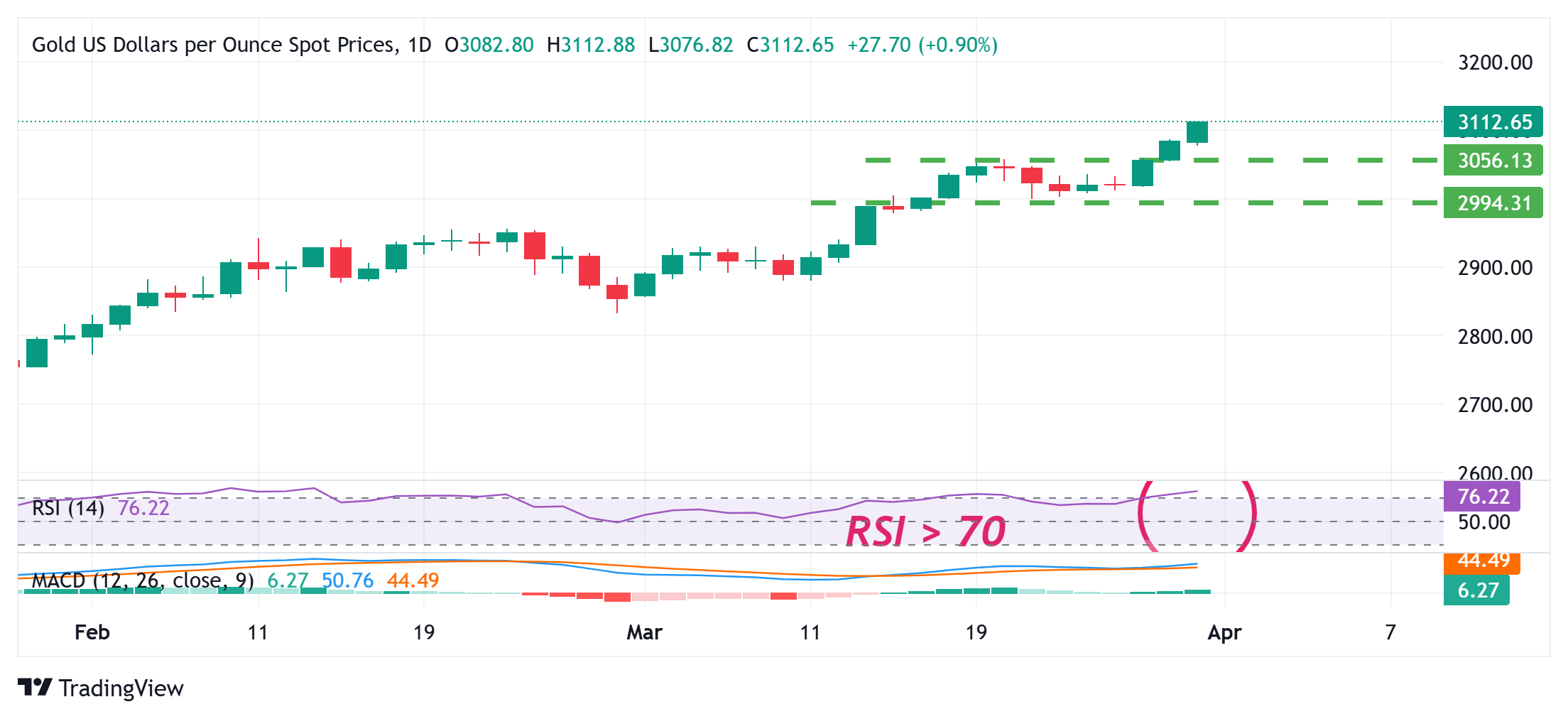Nuestros mejores spreads y condiciones
 Más información
Más información
Gold price (XAU/USD) attracts strong follow-through buying for the third consecutive day and climbs beyond the $3,100 mark, hitting a fresh all-time peak during the Asian session on Monday. Worries over US President Donald Trump's reciprocal tariffs, due to be announced on Wednesday, and their impact on the global economy continue to weigh on investors' sentiment. Apart from this, persistent geopolitical risks drive safe-haven flows toward the precious metal and remain supportive of the positive move.
Meanwhile, the US Dollar (USD) selling remains unabated for the third straight day on the back of expectations that the Federal Reserve (Fed) will resume its rate-cutting cycle soon amid a tariff-drive US economic slowdown. This overshadows Friday data, pointing to signs of rising inflation in the US, and turns out to be another factor underpinning the non-yielding Gold price. The XAU/USD bulls, however, could pause for a breather amid overbought conditions, warranting caution before positioning for further gains.

From a technical perspective, Friday's sustained breakout above the previous all-time peak, around the $3,057-3,058 region, was seen as a fresh trigger for bullish traders. That said, the Relative Strength Index (RSI) on the daily chart remains above the 70 mark for the third straight day and points to overstretched conditions. Hence, it will be prudent to wait for some near-term consolidation or a modest pullback before positioning for an extension of the recent well-established uptrend witnessed over the past three months or so.
Meanwhile, any corrective pullback below the Asian session low, around the $3,076 area, now seems to find decent support near the aforementioned resistance breakpoint. This is followed by the $3,036-3,035 support zone, below which the Gold price could accelerate the slide back towards retesting the $3,000 psychological mark. The latter should act as a key pivotal point, which if broken decisively might shift the near-term bias in favor of bearish traders and pave the way for deeper losses.
Gold has played a key role in human’s history as it has been widely used as a store of value and medium of exchange. Currently, apart from its shine and usage for jewelry, the precious metal is widely seen as a safe-haven asset, meaning that it is considered a good investment during turbulent times. Gold is also widely seen as a hedge against inflation and against depreciating currencies as it doesn’t rely on any specific issuer or government.
Central banks are the biggest Gold holders. In their aim to support their currencies in turbulent times, central banks tend to diversify their reserves and buy Gold to improve the perceived strength of the economy and the currency. High Gold reserves can be a source of trust for a country’s solvency. Central banks added 1,136 tonnes of Gold worth around $70 billion to their reserves in 2022, according to data from the World Gold Council. This is the highest yearly purchase since records began. Central banks from emerging economies such as China, India and Turkey are quickly increasing their Gold reserves.
Gold has an inverse correlation with the US Dollar and US Treasuries, which are both major reserve and safe-haven assets. When the Dollar depreciates, Gold tends to rise, enabling investors and central banks to diversify their assets in turbulent times. Gold is also inversely correlated with risk assets. A rally in the stock market tends to weaken Gold price, while sell-offs in riskier markets tend to favor the precious metal.
The price can move due to a wide range of factors. Geopolitical instability or fears of a deep recession can quickly make Gold price escalate due to its safe-haven status. As a yield-less asset, Gold tends to rise with lower interest rates, while higher cost of money usually weighs down on the yellow metal. Still, most moves depend on how the US Dollar (USD) behaves as the asset is priced in dollars (XAU/USD). A strong Dollar tends to keep the price of Gold controlled, whereas a weaker Dollar is likely to push Gold prices up.